Log Cabin Tools Required to Build a Log Cabin
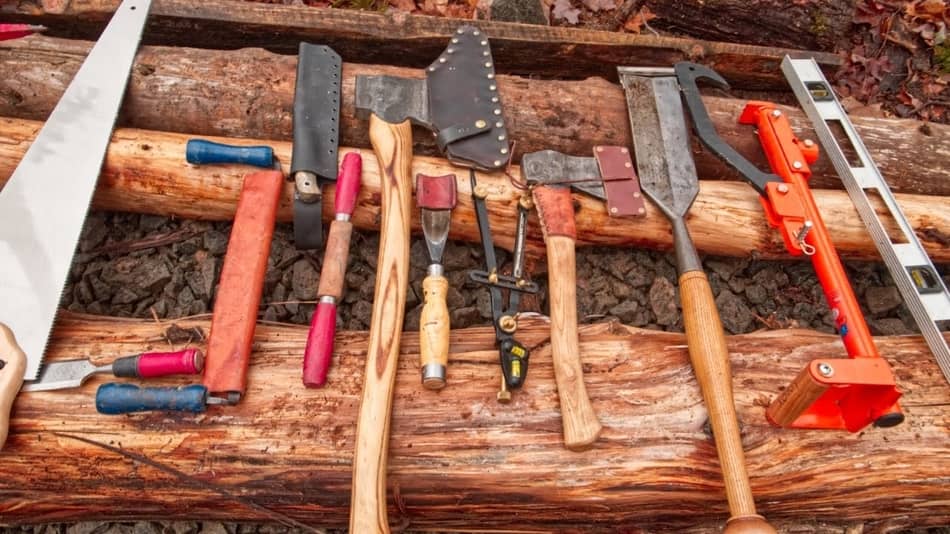
One of the most important parts when it comes to building a log cabin is the proper selection of tools. In this article, we’ll address the essential log cabin tools, the reason behind using each of these tools, the proper way to handle them, and possible replacement tools that you can use.
There are two types of log cabin building tools: traditional tools and power tools. When it comes to log working hand tools, many people might be put off by the fact that building using these hand tools might take longer. Nevertheless, constructing a log home is still fairly easy with the use of hand tools, and the wonderful finish will definitely make this feat worthwhile.
Among the hundreds of hand tools that you can use to build a log cabin, such as log dogs, log cleats, cant hooks, or peaveys, this article will focus on the 7 must-have log cabin tools without which it is practically impossible to build a log cabin. So, let’s start!
Also, be sure to read the Pros And Cons Of Log Cabin Homes.
Table of Contents
7 Required Tools To Build a Log Home
- Adze – For Cutting or Shaping Logs
- Axe – For Cutting Down or Making Dents in the Logs
- Chainsaw – For Cutting Logs
- Drawknife – For Peeling and Debarking Logs
- Log Dog – For Holding Logs
- Mallet – For Hitting Logs
- Peavey – For Moving Logs Around
Investing in quality tools is an investment that pays off in the long run as you can use these tools in many other building projects, but also to maintain the proper look and functionality of your log cabin. Be sure to read the rest of the article if you want to find out which tools are essential and how to use them when it comes to building a log cabin.
1. Adze – For Cutting or Shaping Logs
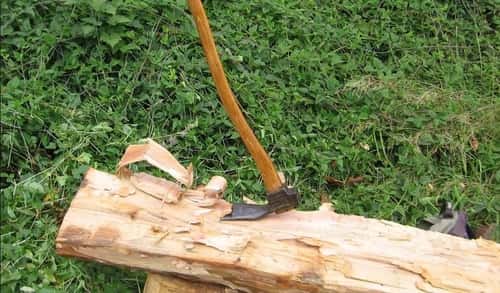
An adze is a tool first used in the stone age for hewing logs. The difference between an axe and an adze is the cutting blade, which stands vertical to the handle at the end of the wooden shaft.
The resemblance between an adze and a gardening hoe is huge, but unlike the gardening hoe, the adze is used for hewing logs. This action is conducted in order to straighten the round edges of a log.
An adze also serves as a replacement for a drawknife, but its main purpose is hewing. To properly use an adze you need to be standing beside or on top of the log and swing between your legs. You will hew the upper side of the log until it becomes flat. The optimal adze to use is a long-handled (30-42”), 3lbs adze. Another tool that is useful when it comes to hewing is the broad axe. It can also be used for detail smoothing, just like the adze.
2. Axe – For Cutting Down or Making Dents in the Logs
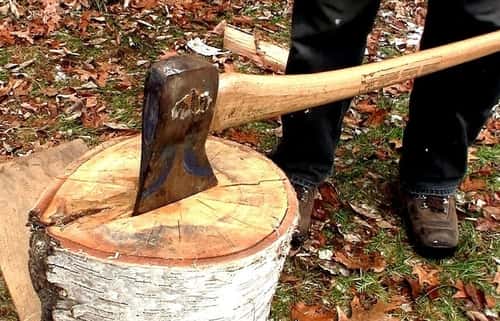
An axe is a hand tool without which the process of building a log cabin would be impossible to imagine. Just like the adze, the axe was first used in the stone age. Its main purpose hasn’t changed since as it is still used for cutting down logs and harvesting and shaping wood.
An axe can also be used for notching logs, but a chainsaw is a way to go since it helps make the process faster and more precise.
How to Use An Axe?
Cutting down trees with an axe can be fairly easy if you know what you’re doing. The first step is to stand next to the log and cut a v-shaped notch at the height of your waist. Repeat the action on the opposite side, but place the v-shaped notch approximately 1 foot higher than the original notch. Finally, repeat the process for a third time 1 foot above the first notch.
The best axe to use would be a long-handled, approximately 26-32”, 4lbs axe. The best ones are made by Helko Werk or Hults Bruk. An alternative option is to use the chainsaw, especially for logs that are over 12” in diameter.
Related Article: The Butt and Pass Log Cabin Method
3. Chainsaw – Used to Cut Logs
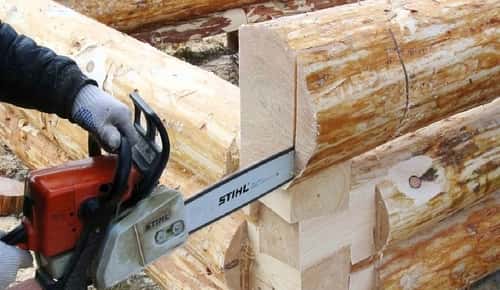
One of the main reasons why someone would like to build a log cabin on their own is cost-effectiveness. In other terms, it is very cheap. The chainsaw, on the other hand, being the only hand-power tool introduced in this blog, is most certainly not cheap.
> Click HERE to buy a Chainsaw<
The uses of a chainsaw are similar to those of an axe, and it can be used for notching, cutting down, or rounding logs. Although it is not cheap, a quality chainsaw, such as a Husqvarna or Makita, preferably with a bar length of 18”, can make the process of building a log cabin much easier and quicker.
4. Drawknife – For Debarking Logs
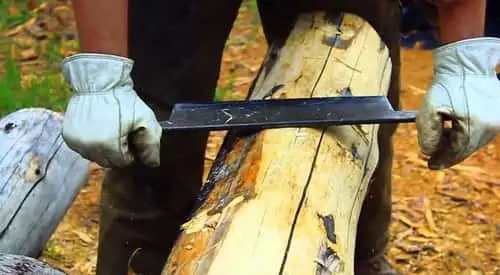
A drawknife is a tool first used in the 1950s. The name drawknife comes from the word itself (“drawing knife”) as you would draw the knife towards you as you used it to peel lumber. Its main purpose is to peel and debark logs, although it can also serve as a replacement for an adze when it comes to hewing.
> Click HERE to buy a Drawknife <
To properly use the drawknife, you need to straddle the log and grip the handles which hold the tapering tangs. The chisel-shaped, flat blade of the drawknife should shave with the grain. When pulling the drawknife toward you, position the blade so that it is vertical in relation to the wood.
If you want to make this process easier, you should cut down the logs in spring and peel them as soon as possible, ideally in the next 48 hours.
A replacement tool for the drawknife is the debarking spud, which can be used when the bark of the log is tacky. To avoid this, you should debark your logs as soon as you cut them down. If you want to stick to the drawknife, the optimal drawknife is around 22”, and its blade is around 13”. This will allow you to debark larger logs.
5. Log Dog – For Holding Logs
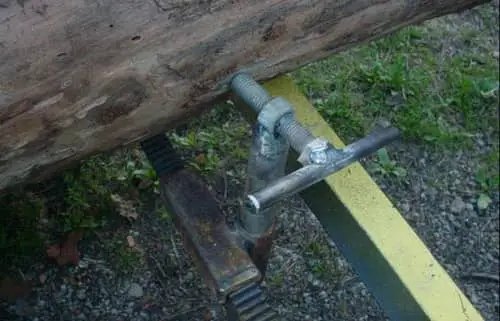
An essential tool to have when it comes to building a log cabin is the log dog. The primary purpose of this iron tool is to hold two logs together, making it easier for you to notch or scribe.
> Click HERE to buy a Log Dog <
Using the log dog is extremely simple, you just have to insert one end of the log dog into a single log and do the same with the opposite side of the log dog and another log. This way your logs will be fixed in place, and you can easily cut, notch, or scribe the logs.
Related Article: How To Build A Survival Cabin? Expert Explain
6. Mallet – Used to Hit the Logs
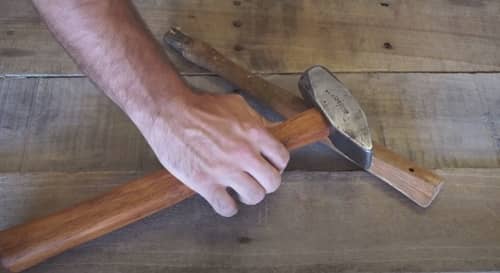
Another important hand tool is the mallet, which is essentially a large hammer, but the mallet’s head is coated in rubber to ensure that the log doesn’t split or spill while you are handling it. Another use of the mallet is to fix the corners of the log cabin together and put the logs in place.
> Click HERE to buy a Mallet <
The mallet is also a great support tool when you are using an adze, a chisel, or a log dog. The best quality mallets are 2 or 3 lbs white rubber mallets. A replacement tool for the mallet is a sledgehammer, but with a sledgehammer, there is a greater chance that you might split or mark the logs.
7. Peavey – For Moving Logs
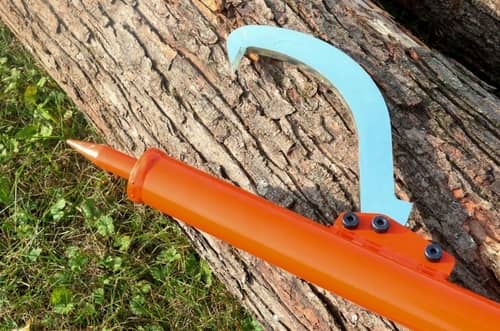
A peavey is a tool that makes moving and rolling logs as easy as it gets. It was invented in the 1850s by Peavey and it is most useful when rolling logs uphill, especially larger logs (more than 12” in diameter).
> Click HERE to buy a Peavey <
Unlike all the other tools we mentioned, the use of the peavey is limited to moving logs. With this in mind, the peavey might seem expensive just for this task, but it will certainly save you a lot of effort. It is extremely useful if you don’t have a vehicle and you need to move uneven logs, especially over shorter distances.
To easily move a log using the peavey, its spike needs to be pushed into a log. The next step is to roll the log using the hook and arm. There are also other options that could help you move logs, such as the cant hook or a heavy-duty flat pry bar. But if you wish to stick to the peavey, it is important to note that the most useful peaveys can roll 20” in diameter and 10 feet in length.
For those who want to learn more, be sure to read How Much Does It Cost To Build A Log Cabin?
FAQ: People Also Ask
1. What Tools Are Needed To Build a Cabin?
Other than the ones we’ve already mentioned, it is important to also acquire some electrical tape, hammers, a measuring tape, a shovel, a pen or a pencil, a flashlight, a straight bar, a level, and speed square pliers. Be sure not to forget the nails, screws, a drill and drill bits, and any other required hardware.
2. Can You Build a Log Cabin Kit Yourself?
If you enjoy DIY and want to be as independent as you can when building your own log cabin, then DIY Log Cabins is the perfect choice for you. They offer a large number of logs-only kits, and your wallet will be thankful as the kits are all under $50,000. In this kit, you get pre-cut logs, plans, and even assembled materials.
3. How Hard Is It To Build a Log Cabin?
The main issue when it comes to building a modern log cabin by yourself is the size of the too large logs. The logs are usually too large, and it would be almost impossible to build a log cabin on your own. To avoid this you could leave the framing of the logs and setting of the foundation to people who are more experienced in the field.
Final Thoughts
Some more tools which you might find useful when building a log cabin are:
- Carpentry Squares
- Chisels
- Log Scribe
- Measuring Tape
- Plumb Bob
- Spirit Level (48″)
That’s all!
Now the only thing to do is to start building your own log cabin. That is, of course, if you have already acquired the tools mentioned in this article. And if you haven’t, then be sure to first check Amazon or Craigslist since you might find second-hand tools which are bound to be cheaper. The prices of new tools vary from $2,500 to $3,500.
The tools mentioned in this article are must-haves if you are to build a log cabin on your own. Only the adze or the peavey might be left out if you were to invest in a logs-only kit or if you have felled or purchased logs. If you have any other ideas or if you have already built your own log cabin using different tools from the ones mentioned, be sure to leave your comment in the comment section below.


Can you be more specific about the content of your article? After reading it, I still have some doubts. Hope you can help me. https://www.binance.com/id/join?ref=GJY4VW8W